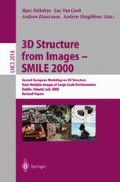Abstract
In this paper, we explore the more practical aspects of building and rendering concentric mosaics. First, we use images captured with only approximately circular camera trajectories. The image sequence capture can be achieved by holding a camcorder in position and rotating the body all around. In addition, we investigate the use of variable input sampling and fidelity of scene geometry based on the level of interest (and hence quality of view synthesized) on the objects in the scene.We achieve the tolerance for minor perturbations about the exact circular camera path and variable input sampling by using and analyzing a variant of the Hough space of all captured rays. Examples using real scenes are shown to validate our approach.
Access this chapter
Tax calculation will be finalised at checkout
Purchases are for personal use only
Preview
Unable to display preview. Download preview PDF.
References
E. H. Adelson and J. R. Bergen. Computation Models of Visual Processing, chapter The plenoptic function and the elements of early vision. MIT Press, Cambridge, MA, 1991.
S. J. Gortler, R. Grzeszczuk, R. Szeliski, and M. F. Cohen. The lumigraph. Computer Graphics (SIGGRAPH’96), pages 43–54, August 1996.
R. Gupta and I. H. Richard. Linear pushbroom cameras. IEEE Transactions on Pattern Analysis and Machine Intelligence, 19(9):963–975, September 1997.
S. B. Kang and R. Szeliski. 3-d scene data recovery using omnidirectional multi-baseline stereo. International Journal of Computer Vision, 25(2):167–183, November 1997.
K. N. Kutulakos. Shape from the light field boundary. In IEEE Computer Society Conference on Computer Vision and Pattern Recognition, pages 53–59, Puerto Rico, June 1997.
M. Levoy and P. Hanrahan. Light field rendering. Computer Graphics (SIG-GRAPH’96), pages 31–42, August 1996.
L. McMillan and G. Bishop. Plenoptic modeling: An image-based rendering system. Computer Graphics (SIGGRAPH’95), pages 39–46, August 1995.
S. Peleg and B. Ben-Ezra. Stereo panorama with a single camera. In IEEE Computer Society Conference on Computer Vision and Pattern Recognition, pages 395–401, Fort Collins, CO, June 1999.
W. H. Press, B. P. Flannery, S. A. Teukolsky, and W. T. Vetterling. Numerical Recipes in C: The Art of Scientific Computing. Cambridge University Press, Cambridge, England, second edition, 1992.
J. Shi and C. Tomasi. Good features to track. In IEEE Computer Society Conference on Computer Vision and Pattern Recognition, pages 593–600, Seattle, WA, June 1994.
H.-Y. Shum and L.-W. He. Rendering with concentric mosaics. Computer Graphics (SIGGRAPH’99), pages 299–306, August 1999.
H.-Y. Shum and R. Szeliski. Stereo reconstruction from multi-perspective panoramas. In International Conference on Computer Vision, pages 14–21, Kerkyra, Greece, September 1999.
J. Stolfi. Oriented projective geometry. In Annual Symposium on Computational Geometry, pages 76–85, Waterloo, Canada, June 1987.
R. Szeliski and S. B. Kang. Recovering 3D shape and motion from image streams using nonlinear least squares. Journal of Visual Communication and Image Representation, 5(1):10–28, March 1994.
Z. Zhang. Flexible camera calibration by viewing a plane from unknown orientations. In International Conference on Computer Vision, pages 666–673, Kerkyra, Greece, September 1999.
References
C. Geyer and K. Daniilidis. A unifying theory for central panoramic systems and practical implications. In Proc. European Conference on Computer Vision, pages 445–461, 2000.
R. Gupta and R. I. Hartley. Linear pushbroom cameras. IEEE Transactions on Pattern Analysis and Machine Intelligence, 19(9):963–975, 1997.
M. Wright, A. W. Fitzgibbon, P. J. Giblin, and R. B. Fisher. Convex hulls, occluding contours, aspect graphs and the Hough transform. Image and Vision Computing, 14(8):627–634, 1996.
Author information
Authors and Affiliations
Editor information
Editors and Affiliations
Rights and permissions
Copyright information
© 2001 Springer-Verlag Berlin Heidelberg
About this paper
Cite this paper
Chai, J., Kang, S.B., Shum, HY. (2001). Rendering with Non-uniform Approximate Concentric Mosaics. In: Pollefeys, M., Van Gool, L., Zisserman, A., Fitzgibbon, A. (eds) 3D Structure from Images — SMILE 2000. SMILE 2000. Lecture Notes in Computer Science, vol 2018. Springer, Berlin, Heidelberg. https://doi.org/10.1007/3-540-45296-6_7
Download citation
DOI: https://doi.org/10.1007/3-540-45296-6_7
Published:
Publisher Name: Springer, Berlin, Heidelberg
Print ISBN: 978-3-540-41845-0
Online ISBN: 978-3-540-45296-6
eBook Packages: Springer Book Archive

